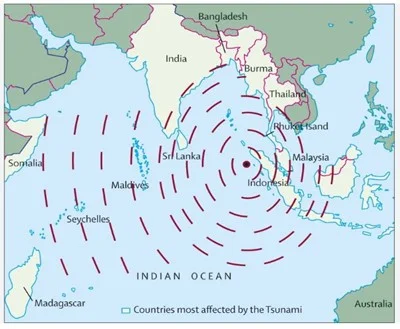Answer:
| Approach:
Introduction
- Start your answer December 2004, tsunami in India.
Body
- Discuss the Factors Responsible for Tsunami Occurrence.
- Effects on Life and Economy.
- NDMA Guidelines for Preparedness.
Conclusion
- Summary of the answer with futuristic approach.
|
Introduction:
A tsunami is a catastrophic oceanic phenomenon, typically caused by submarine earthquakes, volcanic eruptions, or landslides. On December 26, 2004, an undersea megathrust earthquake off the west coast of northern Sumatra triggered one of the deadliest natural disasters in history, causing severe destruction in 14 countries, including India. The tragedy underlined the necessity for a well-structured disaster preparedness and mitigation strategy. The guidelines set forth by the National Disaster Management Authority (NDMA) in 2010 outline a strategic approach to deal with such disasters in the future.
Body:
Factors Responsible for Tsunami Occurrence
- Submarine Earthquakes: The 2004 tsunami was triggered by a severe undersea earthquake at the Indian-Burmese tectonic plates boundary.
- Water Displacement: The earthquake’s vertical movement displaced massive water volumes, creating far-reaching waves.

Effects on Life and Economy
- Human Impact: Over 230,000 people lost their lives globally, with India’s coastal regions like Tamil Nadu and the Andaman and Nicobar Islands suffering significantly.
- Infrastructure Damage: Vital infrastructure, such as the Indira Gandhi Hospital in the Andaman and Nicobar Islands, was damaged, impacting healthcare delivery.
- Socio-Economic Disruption: The fishing industry in regions like Nagapattinam in Tamil Nadu faced severe losses, impacting livelihoods and leading to economic hardships.
NDMA Guidelines for Preparedness
- Early Warning System: The Indian Tsunami Early Warning System (ITEWS) at the Indian National Centre for Ocean Information Services (INCOIS) was established for faster tsunami assessment.
- Structural Mitigation Measures: Coastal structures in tsunami-prone regions like Kerala have been upgraded to withstand tsunamis better.
- Non-Structural Measures: Community-based disaster management programs in regions like Odisha have been successful in reducing risk and enhancing community resilience.
- Capacity Building: Training programs for National Disaster Response Force (NDRF) teams, healthcare professionals, and local communities have been prioritized.
- Awareness Generation: Public awareness campaigns, such as those conducted by schools and local governments in coastal regions, inform about tsunami risks and necessary precautions.
Conclusion:
The 2004 tsunami was a grim reminder of the devastating potential of natural disasters and the importance of preparedness and mitigation strategies. Following the NDMA guidelines, India has made significant strides in disaster risk reduction. Still, more needs to be done, especially at the community level, to build resilient societies that can respond to and recover from such catastrophic events. As we continue to combat the impacts of climate change, enhancing our resilience to natural disasters remains a crucial challenge and a vital necessity.
